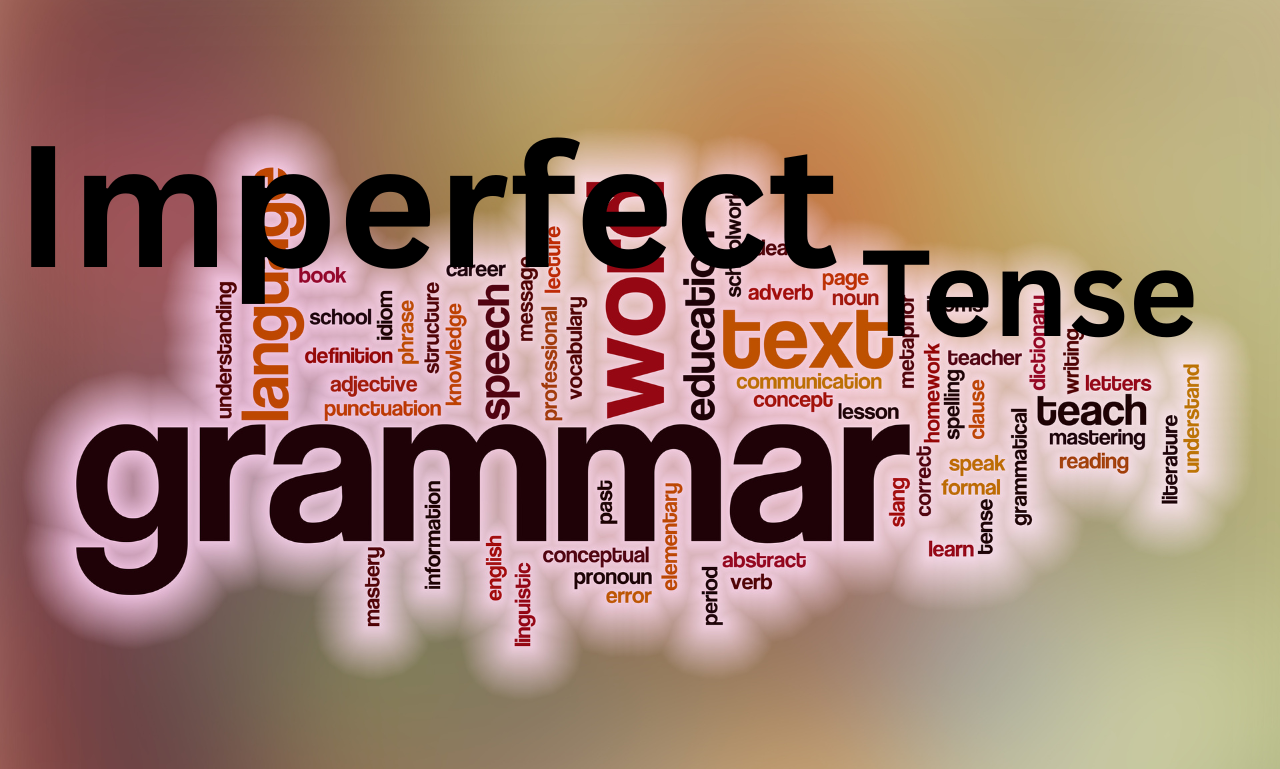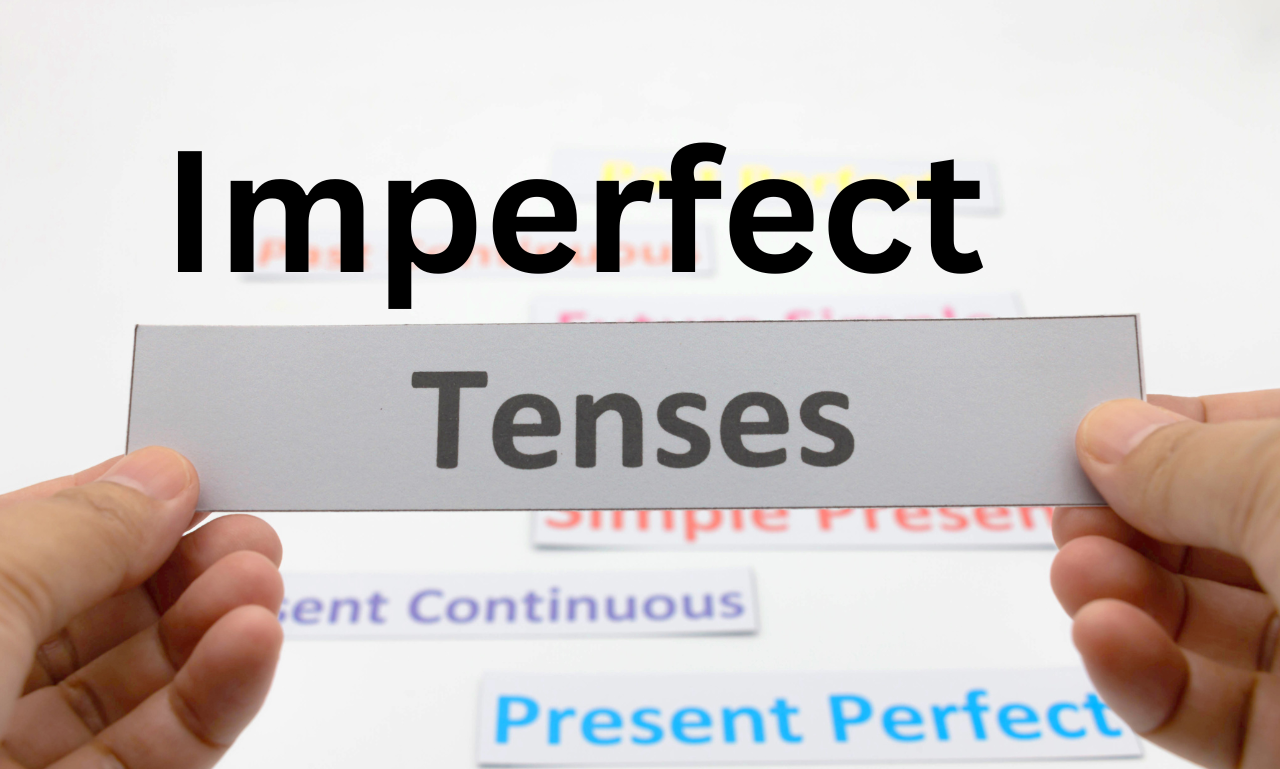While English doesn’t have a specific “Imperfect Tense” like some other languages (such as Spanish or French), it expresses the same idea using past continuous and used to forms.
The imperfect tense generally describes actions that were ongoing, habitual, or repeated in the past without a definite beginning or end. Examples:
- Past Continuous – for ongoing or interrupted actions in the past:
- “I was reading when the phone rang.”
- “They were playing outside all afternoon.”
- Used to / Would – for habitual actions in the past:
- “She used to walk to school every day.”
- “We would go camping every summer.”
These forms help us describe situations, habits, or actions that happened over a period of time in the past, rather than a single completed event.

What Is the Imperfect Tense?
The imperfect tense refers to a way of describing past actions that were ongoing, repeated, or not completed at a specific point in time. While English does not have a formal verb tense called the “imperfect,” it expresses imperfect meanings using other past tense structures—especially the past continuous tense and the “used to” or “would” forms.
In contrast to the simple past (which shows a completed action), the imperfect aspect focuses on the background or duration of an action, or on a repeated behavior in the past.
Examples:
- “I was watching TV when the lights went out.” (ongoing action)
- “We used to play outside until it got dark.” (habitual past action)
- “He would visit his grandmother every weekend.” (repeated past action)
These constructions help set the scene or provide context in narratives, showing what was happening or what was common in the past, rather than what simply occurred and ended.
Would you like explanations of the other headings next?
Expressing Ongoing Past Actions
To express ongoing actions in the past, English uses the past continuous tense. This form describes actions that were happening at a specific moment in the past, often in contrast with another event that occurred during that time.
Structure:
Subject + was/were + verb(-ing)
Examples:
- “She was studying when her friend called.”
- “They were playing football all afternoon.”
- “I was cooking dinner at 7 p.m.”
The past continuous is useful for:
- Describing the background of a story.
- Showing that an action was in progress before it was interrupted.
- Highlighting simultaneous ongoing actions (e.g., “While I was reading, he was writing“).
This usage captures the essence of the imperfect aspect in English—emphasizing duration, incompletion, or interruption in the past.
Would you like to continue with the next heading: Describing Repeated or Habitual Actions?

Describing Repeated or Habitual Actions
To describe repeated or habitual actions in the past, English commonly uses “used to” and “would”. These structures convey the idea of things that happened regularly in the past but no longer occur.
1. Used to + base verb
This form emphasizes past habits or states that are no longer true.
Examples:
- “I used to live in London.” (Now I don’t.)
- “We used to go swimming every weekend.”
2. Would + base verb
This form also shows repeated past actions but is usually used in storytelling or descriptions—not for past states.
Examples:
- “Every summer, we would travel to the countryside.”
- “My grandfather would tell us stories by the fire.”
Note: Don’t use “would” for past states (like emotions, conditions, or locations). Use “used to” or the simple past instead.
- “I used to be shy.”
- “I would be shy.” (incorrect in this context)
These expressions help add depth and continuity to descriptions of the past, much like the imperfect tense in other languages.
Would you like to move on to Imperfect Tense vs. Simple Past?
Imperfect Tense vs. Simple Past
Although English doesn’t officially have an “imperfect tense,” it expresses imperfect meaning through forms like past continuous, used to, and would. These contrast with the simple past, which describes completed actions or events that happened once in the past.
Here’s how they differ:
1. Simple Past
- Focuses on a completed action at a specific time.
- Answers “What happened?”
Examples:
- “I watched a movie last night.”
- “She left the party early.”
2. Imperfect Forms (Past Continuous, Used to, Would)
- Focus on actions that were ongoing, repeated, or part of the background.
- Answer “What was happening?” or “What used to happen?”
Examples:
- “I was watching a movie when the power went out.” (ongoing)
- “She used to leave the party early every time.” (habitual)
- “He would always bring a book to class.” (habitual)
Key Differences:
| Feature | Simple Past | Imperfect Forms |
|---|---|---|
| Action type | Completed, one-time | Ongoing, habitual, repeated |
| Time focus | Specific moment | Unspecified or continuous |
| Example | “He ate dinner.” | “He was eating when I called.” |
Common Mistakes and Tips
When using imperfect-like forms in English (such as past continuous, used to, and would), learners often make mistakes that can lead to confusion or incorrect meaning. Here are some common errors and tips to avoid them:
1. Using “would” for past states
- “I would live in New York when I was a child.”
- “I used to live in New York when I was a child.”
Tip: Use “used to” or the simple past for past conditions, emotions, or situations—not “would.”
2. Confusing past continuous with simple past
- “I was eating lunch and left.”
- “I was eating lunch when she arrived.”
- “I ate lunch and then left.”
Tip: Use past continuous for ongoing actions and simple past for completed actions.
3. Incorrect structure of past continuous
- “She was to play piano.”
- “She was playing the piano.”
Tip: Always use “was/were + verb-ing” for past continuous.
4. Overusing “used to”
- “I used to go to the store yesterday.”
- “I went to the store yesterday.”
Tip: Use “used to” for repeated or long-term past habits, not one-time events.
5. Mixing time expressions incorrectly
- “I was watching TV yesterday at 8 p.m.” (technically okay, but may be unclear)
- “I was watching TV when the phone rang.”
Tip: Use past continuous with a clear context of interruption or parallel action, not just a past time stamp.
By mastering these distinctions and forms, you can express past events in a more natural and descriptive way—just as the imperfect tense allows in other languages.
Conclusions:
While English doesn’t have a specific “imperfect tense” like some other languages (e.g., Spanish imperfecto), it expresses the same ideas using other constructions, typically:
- “Was/were + -ing” for ongoing actions
- I was eating when she arrived.
- “Used to” or “would” (for habitual past actions)
- I used to play soccer every weekend.
- Every summer, we would go to the lake.
So, in English, the imperfect aspect is used to talk about:
- Actions in progress in the past
- Repeated or habitual past actions
- Background descriptions (time, weather, feelings, setting)
In summary, English expresses the imperfect aspect through verb phrases rather than a specific tense form.
FAQs:
- What is the imperfect tense with examples?
The imperfect tense is a grammatical concept used to describe past actions that were ongoing, repeated, habitual, or not completed. While English doesn’t have a verb tense officially called the “imperfect tense” (as languages like Spanish or French do), English still conveys the same imperfect aspect using certain past tense forms—mainly the past continuous and “used to” / “would” constructions. She was dancing in the rain. She was preparing the dinner.
- What is the difference between perfect and imperfect tense?
The perfect and imperfect tenses both describe past actions, but they focus on different aspects of time and completion. Here’s a clear comparison:
- When should I use imperfect tense?
You should use the imperfect tense in a language like Spanish, French, or Italian (and others with similar grammar) when you’re talking about past actions or states that are ongoing, habitual, repeated, or incomplete. Here’s a breakdown of common cases.

